#writersofinstagram
Text
Shuffling Ideas - a free game for writers
Hello hello, it's me, Rach! And today I’m bringing another... FREEBIE!
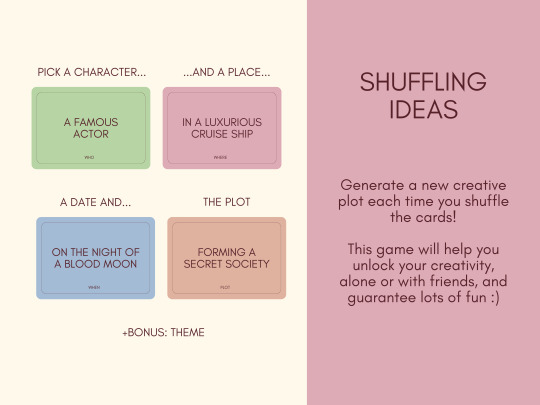
Are you looking for fun ways to brainstorm ideas? I have the solution right here (and it's free!)
Shuffling Ideas is a creative card game designed to be versatile and can be enjoyed both solo and in a group setting. When playing solo, you can use the cards to challenge your creativity, overcome writer’s block, or simply have fun concocting new and exciting plots. It’s a fun way to practice your writing skills and let your imagination run wild with over 1 million different plot combinations at your disposal. So, whether you’re in the mood for some quiet writing time or looking to brainstorm story ideas, Shuffling Ideas is the perfect go-to.
You’ll receive a PDF file ready for download, ensuring instant access to the game. No waiting, no shipping fees!
With 22 pages of content, you have the flexibility to print only the 10 pages required for the card fronts, saving you ink and paper
Over 1 million different plot combinations are possible, ensuring that no two writing sessions are ever the same.
So, if you're ready to have fun while unlocking your creative side, grab your freebie now and get started!
Oh, and don’t forget to tag your creative buddies who would love this and spread the word!
Get it here!!
#freebie#free#card game#writing resources#writing#writeblr#writer tips#writing advice#writing help#writing tips#poetsandwriters#resources#research#wattpad#nanowrimo#creative writing#writerscommunity#writers#writing inspiration#writing prompts#writing reference#writerslife#writersofinstagram#software#inspiration#writing inspo#for writing#for writers#for whoever needs it#useful resources
33 notes
·
View notes
Text

Jane Austen, from a letter to her sister Cassandra Austen
#june quotes#poetry#writersofinstagram#writing#writersociety#poems#quotes#aesthetic#poemsbyme#poemsociety#love
22 notes
·
View notes
Text

Slyvia Plath
#poets corner#poet#poetry#vintage#nature#diary#life#poetic#love#dark academia#dark acadamia quotes#dark academic aesthetic#sylvia plath#unfeignedwriter#writersofinstagram#writers in tumblr
6K notes
·
View notes
Text
Being a writer is just 97% googling words to make sure they mean exactly what you always assumed they meant.
#writing#writersofinstagram#writblr#writers on tumblr#writing memes#writerscommunity#reading memes#writerscorner#reading#author#writerslife#authors#wrtblr#indieauthor#indie writer
49K notes
·
View notes
Text
Tips for Beginner Writers
1 - Make a chapter out line as you go, so if you need any sort of information about what's happened in the book, you don't have to scroll through each and every paragraph you wrote.
2 - Your first draft is not Your published book, you're gonna have to revise it and edit it a lot over the while, so Let it Suck. It'll turn into a second, third draft, and published book in the end.
3 - What matters is that you wrote, not how much you wrote. Try to set a daily number of words for you to write, that way you get consistency and it gives you a routine to follow.
4 - Remember that many books have been written, many with the same premise, but by different people. If you worry that your idea is too average or too oversaturated remember this:
5 - Don't make scenes too long, dont detail what you don't need to. If your character is going to develop via an event, detail it where needed, don't detail every little thing because it makes the scene unnecessarily long.
This Idea has been written before, but not by you.
#creative writing#writing#writing ideas#writers#writers on tumblr#writerscommunity#writeblr#writing community#writing tips#tips#tips and tricks#beginner writer tips#writersofig#write#female writers#writersofinstagram#writersociety#fic writing#how to#guide
920 notes
·
View notes
Text
Forging Epic Battles: Techniques for Writing Gripping War Scenes
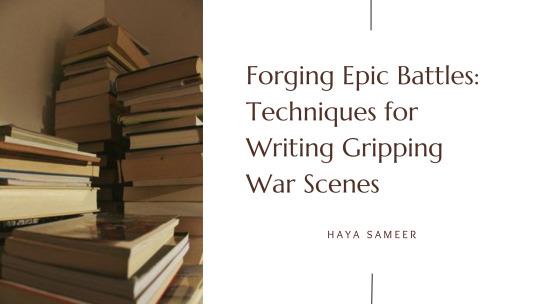
I want to start this post off with sort of an author's note: this is a long one! I tried to keep my detailing to a minimum but I guess this topic Is just so vast I couldn't help but pour it all out. This really is sort of an ultimate guide and I hope it helps! Also, it was requested by @xweirdo101x (if you want to request something just send me an ask)
War has long captivated readers' imaginations, evoking a sense of grandeur, sacrifice, and the clash of ideologies. As writers, we have the power to transport our readers to the frontlines, immersing them in the chaos, drama, and emotion of epic battles.
Crafting gripping war scenes requires a delicate balance of research, skillful storytelling, and an understanding of the human experience in times of conflict. In this guide, I will explore various techniques that will help you create dynamic and compelling war narratives, transporting your readers to the heart of the action and leaving them breathless.
Setting the Stage: Creating a Compelling War Setting
When it comes to writing gripping war scenes, creating a vivid and immersive setting is paramount. Whether you are crafting a historical war or inventing a fictional conflict, the setting serves as the backdrop against which your characters and their stories unfold. Here are essential steps to help you create a compelling war setting that captures readers' imaginations:
Research Historical Context or Build a Fictional World:
For historical wars, immerse yourself in research to understand the time period, social dynamics, and political climate surrounding the conflict. This knowledge will lend authenticity and depth to your narrative.
If you're building a fictional world, establish the rules, geography, and cultural aspects that shape the war. Consider the unique elements that set your world apart and make it feel real to readers.
Describe the Physical Environment and Atmosphere:
Depict the landscape, whether it's a war-torn city, a rugged battlefield, or a desolate wasteland. Pay attention to sensory details—sights, sounds, smells—to transport readers into the heart of the war.
Convey the atmosphere of the setting, capturing the tension, fear, or anticipation that hangs in the air. Is it shrouded in darkness and despair, or does a glimmer of hope persist? Use descriptive language to evoke the desired emotional response.
Incorporate Cultural and Societal Elements:
Explore how the war has affected the culture and society within your setting. Are there new traditions, rituals, or customs that have emerged in response to the conflict?
Consider the social dynamics at play—class divisions, power struggles, or the impact of war on marginalized groups. These elements add layers of complexity to your setting and provide opportunities for conflict and character development.
By carefully constructing your war setting, you transport readers into a world brimming with authenticity and intrigue. Whether it's the trenches of World War I, a futuristic intergalactic battle, or a mythical realm engulfed in strife, the setting sets the stage for compelling storytelling.
Building Conflict and Tension
In the realm of war fiction, conflict and tension are the driving forces that propel your narrative forward and keep readers captivated. From the clash of opposing ideologies to the internal struggles within characters, here are essential techniques for building conflict and tension in your war scenes:
Establish Clear Goals and Stakes for Characters:
Define the objectives and desires of your main characters within the war. What are they fighting for? What personal or collective goals are at stake?
Create conflicts of interest between characters, where their motivations and objectives may diverge, leading to tension-filled interactions and confrontations.
Introduce Opposing Forces and Ideologies:
Develop compelling adversaries that challenge your protagonists. These opposing forces may represent different sides of the conflict, ideologies, or even personal vendettas.
Explore the contrasting beliefs, values, and philosophies driving each side, heightening the ideological clash and intensifying the conflict.
Utilize Internal Conflicts within Characters:
Explore the internal struggles and moral dilemmas faced by your characters. How does the war affect their beliefs, principles, and sense of self?
Delve into the emotional turmoil and psychological toll of war, showcasing the internal battles characters face as they navigate the chaos and make difficult choices.
By effectively building conflict and tension, you create a dynamic and engaging narrative that keeps readers invested in your war story. The clash of goals, the ideological friction, and the internal struggles of your characters add layers of complexity and depth to your storytelling, drawing readers deeper into the heart of the conflict.
Developing Dynamic Characters
In the realm of war fiction, dynamic and well-developed characters are essential to breathe life into your narrative and create an emotional connection with readers. By crafting relatable protagonists and antagonists, you elevate the impact of your war story. Here are key considerations and techniques for developing dynamic characters within the context of war:
Crafting Relatable Protagonists:
Give your main characters depth and complexity by exploring their backgrounds, motivations, and personal histories. What drives them to participate in the war? What are their hopes, fears, and vulnerabilities?
Develop relatable goals and desires for your protagonists that resonate with readers. Show how the war impacts their lives and pushes them to grow, change, or make difficult decisions.
Creating Compelling Antagonists:
Craft antagonists who are more than just one-dimensional villains. Give them their own motivations, beliefs, and reasons for engaging in the war. This adds depth and complexity to their characters, creating a sense of empathy or understanding.
Explore the potential for redemption or transformation within your antagonists. Are they driven by misguided ideals, personal vendettas, or the pressures of their circumstances? Allow their development to challenge readers' perspectives.
Conveying the Psychological Impact of War:
Explore the emotional and psychological toll that war takes on your characters. Depict their fears, traumas, and inner conflicts as they grapple with the horrors and realities of the battlefield.
Show the evolution of their beliefs and perspectives as they confront the brutalities of war. Allow their experiences to shape their character arcs, highlighting the resilience, resilience, and vulnerabilities that emerge in the face of adversity.
By developing dynamic characters in your war narrative, you create a multi-dimensional and emotionally resonant story. Readers will become invested in their journeys, experiencing the triumphs, losses, and personal transformations that unfold throughout the war.
Writing Action-Packed Battle Scenes
Action-packed battle scenes are the heart of war fiction, where the intensity and stakes are at their highest. These scenes immerse readers in the chaos, danger, and adrenaline of the conflict. To craft gripping battle scenes, consider the following techniques:
Structuring Battle Sequences for Maximum Impact:
Begin with a clear sense of purpose for the battle scene. What are the objectives? What is at stake? Establish the goals and set the stage for the conflict.
Build tension gradually, starting with smaller skirmishes or encounters that escalate toward the climactic moments. Consider pacing, alternating moments of heightened action with moments of respite for emotional impact.
Balancing Fast-Paced Action and Descriptive Details:
Use concise and vivid language to convey the fast-paced nature of battle. Focus on capturing the essence of the action, highlighting key movements, and sensory details that immerse readers in the experience.
Strike a balance between brevity and providing enough detail to engage the reader's imagination. Avoid overwhelming readers with excessive description, ensuring that every word serves a purpose and contributes to the overall impact.
Using Sensory Language to Immerse Readers:
Engage multiple senses to transport readers into the battle scene. Describe the sights, sounds, smells, and tactile sensations to evoke a visceral experience.
Leverage sensory details to enhance the emotional impact of the battle, capturing the fear, adrenaline, and urgency felt by characters and evoking a similar response in readers.
Good action-packed battle scenes bring the war to life on the page, immersing readers in the heart-pounding action. Remember to focus not only on the physical aspects of combat but also on the emotional and psychological experiences of your characters.
Conveying Emotional Resonance
In war fiction, it is crucial to convey the emotional impact of the conflict on both individual characters and the larger society. By tapping into the raw emotions experienced during times of war, you can create a profound connection with your readers. Here are key techniques for conveying emotional resonance in your war narrative:
Show the Human Cost of War:
Portray the personal sacrifices, losses, and tragedies that characters endure in the face of war. Highlight the emotional toll on their relationships, families, and communities.
Explore the range of emotions experienced by characters, such as fear, grief, anger, and resilience. Through their struggles, allow readers to empathize with the profound impact of war on the human psyche.
Engage the Senses to Evoke Emotion:
Utilize sensory language to evoke emotions within readers. Describe the sights, sounds, smells, and tactile sensations associated with war to create a vivid and immersive experience.
Connect specific sensory details to the emotions they evoke. For example, the acrid stench of smoke may elicit a sense of danger or the distant cries of anguish may stir feelings of sorrow.
Develop Authentic and Complex Relationships:
Showcase the bonds formed and tested amidst the chaos of war. Explore friendships, romances, and the camaraderie among soldiers to highlight the connections that sustain characters in the face of adversity.
Depict the conflicts and tensions that arise within relationships due to the strain of war. This adds layers of emotional complexity and authenticity to your narrative.
By effectively conveying emotional resonance, you invite readers to experience the human side of war. They will connect with the characters on a deeper level and become emotionally invested in their journeys.
Navigating Moral and Ethical Dilemmas
War is often accompanied by moral and ethical dilemmas that test the values and principles of individuals and societies. As a war fiction writer, it is important to explore these complexities and shed light on the difficult choices characters face. Here are key considerations for navigating moral and ethical dilemmas in your war narrative:
Present Conflicting Perspectives:
Introduce characters with differing moral viewpoints and beliefs. Show the diversity of perspectives within the war, whether it's among the protagonists, antagonists, or the larger society.
Challenge readers to contemplate the gray areas of morality and the complexities of right and wrong by presenting conflicting viewpoints and the reasons behind them.
Highlight the Consequences of Choices:
Illustrate the consequences of characters' actions and decisions. Showcase how their choices ripple through the narrative, affecting themselves and those around them.
Explore the moral dilemmas characters face, such as choosing between duty and personal convictions, sacrificing the few for the many, or grappling with the aftermath of their actions.
Offer Reflection and Discussion:
Provide opportunities for characters to reflect on their choices, engaging in internal dialogue or discussions with others. This allows readers to contemplate the moral implications alongside the characters.
Invite readers to reflect on their own moral compass and engage in discussions surrounding the ethical dimensions raised in your war narrative.
Navigating moral and ethical dilemmas makes your war fiction go beyond the surface-level action and delve into the deeper questions of humanity. It prompts readers to question their own values, moral boundaries, and the intricate web of choices that arise in times of conflict.
Research and Authenticity in War Fiction
For war fiction to have a lasting impact, it is crucial to conduct thorough research and strive for authenticity in your narrative. By grounding your story in accurate details and historical context, you enhance its credibility and immerse readers in the world of war. Here are key considerations for incorporating research and authenticity in your war fiction:
Study Historical Events and Settings:
Research the historical events, conflicts, and time periods that serve as the backdrop for your war narrative. Gain a comprehensive understanding of the context, including the political, social, and cultural factors that influenced the war.
Dive into the specifics of battle strategies, weaponry, and tactics employed during the time period. This knowledge will help you create authentic and realistic war scenes.
Explore Personal Accounts and Memoirs:
Read personal accounts, memoirs, and interviews of individuals who have experienced war firsthand. These sources provide invaluable insights into the emotions, challenges, and nuances of the human experience during wartime.
Pay attention to the details of daily life, the physical and psychological tolls, and the individual stories of courage, sacrifice, and resilience. Incorporate these elements into your narrative to add depth and authenticity.
Consult Experts and Military Advisers:
Seek guidance from military advisers, historians, or experts in the field to ensure accuracy in depicting military operations, protocols, and terminology.
Engage in conversations or interviews with individuals who have expertise in areas relevant to your story, such as veterans, soldiers, or scholars. Their perspectives can offer valuable insights and help you portray the realities of war with authenticity.
Strive for Emotional Truth:
While research and accuracy are crucial, remember that emotional truth is equally important. Balance historical accuracy with the emotional resonance of your characters and their experiences.
Capture the human aspects of war, such as the impact on relationships, the psychological trauma, and the bonds forged in the face of adversity. Connect readers to the emotional core of your story.
By incorporating thorough research and striving for authenticity, you create a rich and immersive war narrative that resonates with readers. The combination of accurate historical details, personal accounts, and emotional depth brings your story to life.
War fiction is a genre that holds immense power to captivate readers, evoke emotions, and shed light on the complexities of human nature during times of conflict. Through the techniques and considerations I have explored in this guide, you have the tools to craft compelling war narratives that resonate with authenticity and engage your readers on a profound level.
I hope this blog on forging epic battles will help you in your writing journey. Be sure to comment any tips of your own to help your fellow authors prosper, and follow my blog for new blog updates every Monday and Thursday.
Looking For More Writing Tips And Tricks?
Are you an author looking for writing tips and tricks to better your manuscript? Or do you want to learn about how to get a literary agent, get published and properly market your book? Consider checking out the rest of Haya’s book blog where I post writing and marketing tools for authors every Monday and Thursday
#hayatheauthor#haya's book blog#haya blogs#writing prompt#writing tools#writing stuff#creative writing#writing tips#writing blog#writer community#writing advice#writer tips#writing community#writer things#writing life#writing things#writing tip#writing techniques#writing topics#writing tool#writing tumblr#writing resources#writing inspiration#writing inspo#writing reference#writer#writersofinstagram#writers on tumblr#writers block
582 notes
·
View notes
Text
How to make a villain's appearance memorable
Making a villain's appearance unique and memorable is important for creating a character that stands out in the audience's mind. Here are some ways to achieve this:
Clothing and accessories: The villain's clothing and accessories can be used to create a unique and memorable appearance. Consider using unusual fabrics, patterns, or shapes to create a distinctive look for the character. Pay attention to fashion style. What do they usually wear? Is their fashion sense good or bad? Casual or unique? They show it through the way they dress every time they appear. Accessories such as jewelry, hats, or gloves can also be used to add visual interest to the character.
Physical features: Physical features such as freckles, moles, scars, tattoos, or piercings are good ingredients for creating a unique look. Unusual facial features, such as a prominent nose or distinctive eye shape, can also be used to create memorable looks.
Makeup and hair: Like clothing, makeup and hair are often used to accentuate the villain. Hair textures, color, size, style, and shape serve as definitive social markers, determining, among other things, one's race or ethnicity, charm, beauty, religion, age, and so on. Meanwhile, makeup can show how much a character cares about his or her appearance. Bold or unusual makeup styles, such as dark or colorful eyeshadows, or distinctive hairstyles like mohawks or shaved heads are also distinctive and interesting highlights.
Symbolism: The villain's appearance can also be used to create symbolism that reflects their personality or motivations. Consider using symbols or motifs that are meaningful to the character, such as an animal or a particular design element.
Body language: Body language and gestures are symbols that tell the character's background and even the relationship between characters. A female villain will have different gestures than a male villain, and an assassin will definitely have fewer redundant movements than a doctor. You can use special gestures or movements that reflect your character's personality or motives.
Through the above characteristics, you can reflect the character's personality as well as some interests without saying it directly. Not only that, a memorable appearance also helps create strong impressions and makes it easy for the reader to create a visual image in their mind.
If you want to read more posts about writing, please click here and give me a follow!

#creative writing#writing#writeblr#writerscommunity#writer things#on writing#own character#writers#writersociety#writer problems#writerscorner#writblr#writers on tumblr#writerslife#amwriting#writersofinstagram#writing tips#writing community#write#villain
475 notes
·
View notes
Text
one bad grade doesn’t make you a lost cause. one act of prioritising yourself doesn’t make you selfish. one day of taking a break doesn’t make you lazy. one person breaking your heart doesn’t make you unlovable and avoiding one million places, people, situations and arguments that lower your self worth and esteem does not make you an escapist.
#desi tag#just desi things#desiblr#relatable content#writers and poets#writersofinstagram#writers on tumblr#desi tumblr#desi academia
155 notes
·
View notes
Text
Writing Scenes Out of Order
Gonna be honest with y'all, I have never ever written a story completely in order. I am actually incapable of doing that. Even though I write the most detailed outlines known to man before I even think about writing, I still can’t write the scenes in order. I swear by this because I sincerely believe that writing scenes out of order increases my productivity which I’ll talk about later. Even if you haven’t done this before, I recommend everyone try it at least once, so without further ado, here are a few reasons that you should write your stories out of order.
You Can Write The Ending First
When you write your scenes in order, generally that means that you’re going to write the ending last. In my experience, the ending is one of the most important things in your story, so I recommend that even if you write everything else in order, always write the ending first. Writing the ending first always gives you a light at the end of the tunnel. It gives you a destination to eventually reach. Even when you feel like your story is going absolutely nowhere, it allows you to go back and see what you want the ending to look like from the beginning which should help your motivation and hopefully lessen that pesky writer’s block!
Oh, Those Continuity Issues
Continuity issues are the absolute worst. I can never seem to remember the way that I described stuff at the end of the book when I’m writing everything back at the beginning. One thing that does get frustrating about writing scenes out of order, is keeping up with continuity like what season it is, what characters have already met, and even who is alive and dead at certain points. Writing scenes in order eliminates these issues because you are writing everything in the order that it happens. I would most definitely recommend keeping an outline or at least a sheet of notes when you’re writing scenes out of order, so that you can keep yourself organized and lessen the continuity issues that you have to go back and fix in later drafts!
You Can Follow Your Inspiration
I plot every scene out extensively, but if I do have an idea for a scene, I immediately write it down and worry about where it fits into the story later. For me, this increases my motivation because at least I'm writing something even if it wasn't in my original outline. Every story has scenes that aren't the most interesting, and as writers, those can be the hardest scenes to write. Especially if you write all of the interesting scenes first, you won't have anything to look forward to when you're struggling through the more transitional parts of the story. This is just my opinion, but whenever I write in chronological order, my motivation goes down a lot. I like writing whatever scenes I want to write instead of writing what comes next in the story. Knowing that I can write whatever scene I want to next makes me super excited about writing
Sprinkle In That Foreshadowing
Y’all know how much I love me some well done foreshadowing. It’s simply one of the best things about reading and writing. But, writing foreshadowing can be really complicated if you aren’t sure how the story ends or even how the foreshadowing will fit into the story later. Because I normally write the ending scenes first, when I finally get around to writing the beginning scenes, I can easily sprinkle in little bits of foreshadowing or allusions to later scenes. It also helps me not overly foreshadow anything because I can go to the end and make sure I'm not doing too much.
#writers#writers on tumblr#writersofinstagram#writerscorner#writing#writing tips#writing things#writing tip#writing advice#writing resources#writing resoure#writing refernece#writing references
1K notes
·
View notes
Text
free resources to write a novel in 2024
hello hello! it's me, rach!
as the new year approaches, many of us set goals and resolutions - myself included. one of my goals for 2024 is to write a novel (I've been procrastinating on this for quite a long time now). i assume that some of you might have the same goal, that's why I'm writing this post today.
over 2023 i've been releasing some freebies for authors just like me, so I thought I could compile my favorites in this post. hope you find this useful :)
1) the writer's workbook
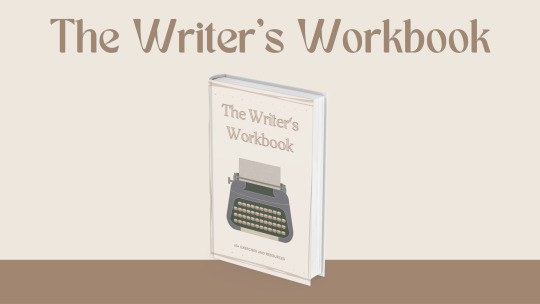
this workbook has over 60 exercises to help you develop characters, scenarios, etc. if you're ever stuck, I'm pretty sure this workbook will be your best friend.
2) author's corner (notion template)

this is the most downloaded freebie in my shop! it is a notion dashboard with everything you need to organize your writing and has some templates included (like scrivener)!!
3) another notion template
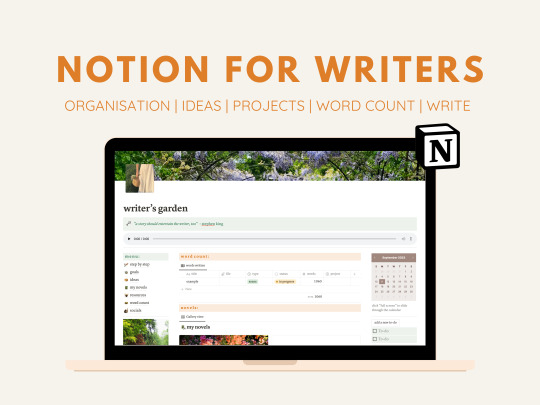
this one has two themes you can choose from: cottage-core and dark academia. they're very similar to the previous template, but this one is more recent and I added some new features. feel free to explore both and pick the one you like the most.
4) the author's journal

this is a cute printable with 20 pages that will help you stay on track and manage your social media accounts as a writer who shares their work online. you can also register what you're currently writing and your personal research and resources.
5) plan your book printable

this is a 6-page printable for you to fill out and plan your book easily and effectively.
6) excel sheet to organize tasks & word-count

this is a simple excel sheet, but it is very effective for keeping track of your tasks & word-count of your novels. also, it is 100% customizable to your liking!
that's all for now! feel free to explore my gumroad shop where I have plenty of freebies to grab! also, don't forget to subscribe so that you never miss any opportunity to get a goodie for free :)
hope this post was useful!
have a nice day,
rach
#writing resources#writing#writeblr#writer tips#writing advice#writing help#writing tips#poetsandwriters#resources#research#wattpad#nanowrimo#creative writing#writerscommunity#writers#writing inspiration#writing prompts#writing reference#writerslife#writersofinstagram#software#inspiration#writing inspo#for writing#for writers#for whoever needs it#writing research#researching#we love an useful post#useful
3K notes
·
View notes
Text
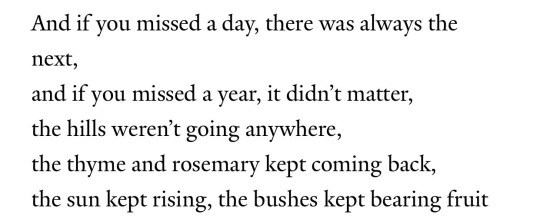
Sunrise, Louise Glück
#poetry#writersofinstagram#writing#writersociety#quotes#aesthetic#poems#poemsbyme#poemsociety#love#sunrise#louise glück
28K notes
·
View notes
Text


MEISTER ECKHART
#poets corner#poet#poetry#vintage#nature#diary#life#poetic#love#dark academia#dark acadamia quotes#dark academic aesthetic#new beginnings#2024#unfeignedwriter#writersofinstagram#writers in tumblr
322 notes
·
View notes
Text
Me whilst writing: This is a masterpiece…I am a literary genius
Me whilst editing my writing: I am an abomination to the writing community
#writing#writersofinstagram#writblr#writers on tumblr#writing memes#authors#writerscommunity#reading#author#writerscorner#writerslife#wrtblr#reading memes#indieauthor#indie writer
19K notes
·
View notes
Text
Writers be Like
At night, in bed, when inspiration strikes; frantically writing everything down in the notes app.
The next day, the notes app: Shex kdkilles the wilow andgets ksilesd then deis but not rellay bcsu she hads maigvcl
#writing#creative writing#writers#writer things#writerscommunity#writerscorner#writerslife#writersofinstagram#writeblr#writers on tumblr#relatable#relatability#night#vs#day#expectations#reality#expectations vs reality#write#writing community
386 notes
·
View notes
Text
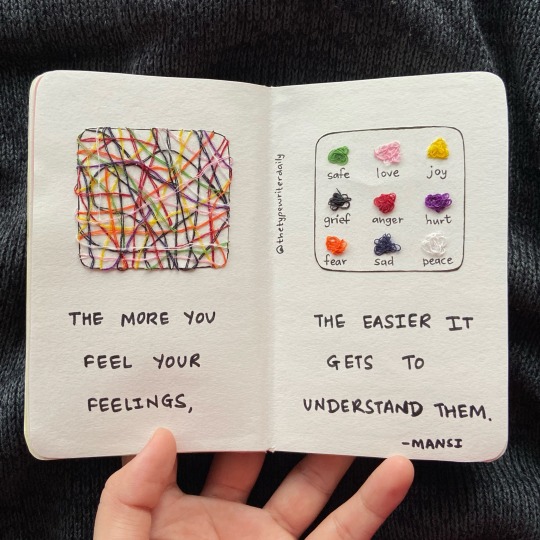
instagram
#wordporn#poetry#words#love#writersofinstagram#wordgasm#poetryisnotdead#typewriterdaily#poet#poetsofig#literature#poetrycommunity#poemsporn#writer#artist#quoteoftheday#mansi#instaquotes#instapoetry#poemsofig#art journal#journaling#art journaling#poetscommunity#mental health#feelings
3K notes
·
View notes
Text
How To Write And Create A Subplot

A subplot is an essential aspect of any book. It helps drive your story forward and hook your readers in with a compelling narrative. A good subplot raises the stakes for the main character by introducing side characters, creating plot twists, adding another dimension to the story or revealing information from the past or future.
However, if executed incorrectly subplots can overshadow your main plot and deviate from the heart of your story. Unsure how to create and execute a subplot? Here are some helpful tips to get you started!
Why Are Subplots Important?
A subplot is a narrative thread that supports the elements of your main plot. They often build conflict or shed light on a secondary character’s story. Subplots help you create multilevel narrative arcs and build complexity and depth.
Your readers certainly don’t need to know what your antagonists were doing while the protagonist underwent secluded training, but adding this subplot builds tension, heightens the stakes and easily portrays personality traits and character flaws. This is especially true for genres such as SFF or horror where your characters often don’t know their enemy’s plan until the last moment.
Subplots are often what make your readers connect with your characters and world-building. To put it simply, if Harry Potter was written without any subplots Rowling could have wrapped up the entire series in one book.
Types Of Subplots
It’s important for authors to branch out and implement more than one subplot in their manuscript. Sticking to one subplot can often result in a poor portrayal of an important moment or make an interesting arc fall flat. A simple way to avoid this is by combining different subplots when working on your manuscript.
Mirror Subplots
Mirror subplots are essentially a subplot that mirrors what your protagonist or antagonist is going through in order to illuminate their personality traits and how they dealt with said situation. A great example of a mirror subplot would be Sophie and Agatha’s dynamics during the first book of A School For Good and Evil.
Sophie and Agatha both start off with essentially the same introduction to characters like Tedros, the faculty, their roommates, etc. but while Sophie uses a negative outlook to harm those around her Agatha focuses more on a problem-solving approach.
Contrasting Subplot
A contrasting subplot is when a smaller character faces the same situation as your protagonist/antagonist but handles the situation differently. For example, a protagonist allowed themselves to be injured in order to safely evacuate a nearby citizen but an antagonist in a similar position used the civilian to shield themselves from the attack.
Contrasting subplots cannot exist unless both characters undergo the same situation, which is why it is important to plan this subplot out before executing it.
Complicating Subplot
Complicating subplots are the most common subplot used in literature. They’re pretty self-explanatory and involve a secondary character creating complications for the protagonist. This can be as simple as your love interest’s sister spreading gossip about the protagonist, or as complicated as a grand political scheme created to turn the protagonist’s allies against them.
Romantic Subplot
Romantic subplots are often confused with romance written as a subgenre. The difference between the two is simple—a book with romance as a subgenre simply includes romantic themes, however, a romantic subplot uses romance to deviate from the main plot.
For example, if your protagonist left their usual environment to attend an event with your love interest for a couple of chapters, that counts as a romantic subplot. However, a character simply having a romantic moment does not constitute as a subplot.
Things To Keep In Mind When Creating A Subplot
Now that I’ve divulged all of the facts associated with writing a subplot, here are some personal tips writers should take into consideration when creating a subplot.
A Subplot Is NOT Its Own Story
This is an important factor many writers often forget when creating a subplot. Subplots are meant to tie into the main plot and move the story forward. They are supposed to be an arc in your story, not a story of their own.
Subplots are a great way to foreshadow events, drop hints, reveal character traits, etc. however, you need to consider whether or not your manuscript needs to have these characters. Your deuteragonist’s tragic past with the antagonist might make for a good story, but you could probably summarise those events within one chapter.
The same can be said for past love interests, ex-friends, training arcs and backstory arcs for minor characters. These factors would all propel your plot forward, however, incorrectly implementing them can ruin your reader’s immersion and deviate from the actual plot.
If you’re unsure whether or not your subplot should be included in your novel, take the time to consider these few questions:
Does your subplot help your protagonist accomplish their main goal? Or does it drastically deviate them from their initial purpose?
Does this subplot introduce a new character, a new side to an old character, or the ‘true’ version of a seemingly good/bad character?
Would your character be unable to attain their long-term goal without this subplot?
Would your world-building, character development, or a certain aspect of the main plot feel confusing if not for this subplot?
If your answer to these was yes, then you probably have a valid subplot on your hands. If not, then you should genuinely consider questions and take into account why you want to include this subplot, to begin with. If your answer is something along the lines of ‘it has so and so scene/dynamic which I really enjoyed or think the readers will like’ then your manuscript would probably do better without that subplot.
Create Conclusive Arcs
Unlike your main plot, subplots are supposed to have a start and finish. They need to have a complete arc and some semblance of a conclusion.
For example, if you were writing a contrasting subplot where the side character decided to abandon another character in order to save themselves, you need to consider what happens once you write out this scene. How do the other characters react to it? Does this impact your side character’s position in the story? And most importantly, how does this impact the rest of your plot?
You need to know where you’re going to go with your story once you have concluded your subplot, and figure out a way to tie your subplot into your main plot.
I hope this blog on how to create and execute a sub plot will help you in your writing journey. Be sure to comment any tips of your own to help your fellow authors prosper, and follow my blog for new blog updates every Monday and Thursday.
Looking For More Writing Tips And Tricks?
Are you an author looking for writing tips and tricks to better your manuscript? Or do you want to learn about how to get a literary agent, get published and properly market your book? Consider checking out the rest of Haya’s book blog where I post writing and marketing tools for authors every Monday and Thursday.
#haya's book blog#haya blogs#hayatheauthor#writing life#writing tools#writing stuff#writing tips#writing prompt#creative writing#writing community#writing is hard#writing advice#writing a novel#writing corner#writing blog#writing description#writing inspo#writing inspiration#writing ideas#writing wip#writers block#writerscommunity#writersofinstagram#writersofig#writers on tumblr#female writers#writer tag#writer tips#writer thoughts
785 notes
·
View notes